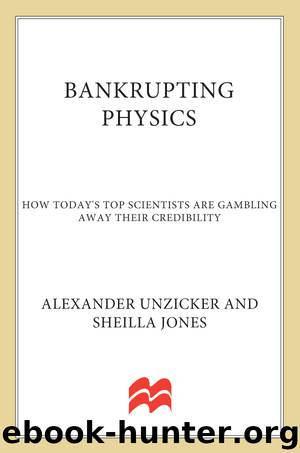Bankrupting Physics by Alexander Unzicker

Author:Alexander Unzicker
Language: eng
Format: epub
Publisher: St. Martin's Press
Published: 2013-10-28T04:00:00+00:00
ON THE CLIFF ABOVE THE OCEAN: THE BIRTH OF QUANTUM THEORY
In the spring of 1925, Werner Heisenberg was tormented by a severe attack of hay fever. He fled to Helgoland, a small German island in the North Sea, where the absence of pollen should have helped him recover. His nose was so violently swollen that his landlady suspected him of having been in a student brawl. Completely undisturbed, Heisenberg pored over the unresolved riddles of atoms. After working on his calculations until sunrise one night, he found out how to describe the puzzling quantum behavior of matter, though the arising formulas were awkward.
Few physicists had a strong mathematical background in the 1920s, and while unwittingly having reinvented matrix algebra to explain electron orbits, Heisenberg had little confidence in the muddle he had come up with. Fortunately, his supervisor, Max Born, was a trained mathematician who immediately recognized the mathematics involved and was able to formalize Heisenberg’s model (a fact that helped math to be taken seriously by physicists).
Bohr’s intriguing model of the atom was hereby vindicated, and even Einstein, as stubbornly skeptical toward the new theory as he was, recognized Heisenberg’s spectacular success: “He has laid a big quantum egg.” Einstein himself, with his famous formula for the energy of light quanta, E = hf (where f is the frequency), had discovered the fundamental importance of the constant h.* But Heisenberg, in 1927, elicited an even more profound meaning from it: h represents the limit of what we can know with certainty—the Heisenberg uncertainty principle.
The quantum h is the barrier of the microscopic world that ultimately hinders our knowledge. If the position of a particle is known, its momentum (the product of its mass and velocity) is not precisely measurable—as is the case when an electron passes through a narrow slit. Metaphorically speaking, every particle resists being captured by jiggling around, a consequence of its wave nature.
The same limitation applies to the relationship between time and energy, two quantities that relate to cosmological conundrums, as mentioned in chapter 4. Following Heisenberg’s principle, you can borrow an amount of energy E out of nothing, if it is readily paid back after the time t = h/E. The uncertainty principle is one of the most important laws of quantum theory, if not all of physics.
Download
This site does not store any files on its server. We only index and link to content provided by other sites. Please contact the content providers to delete copyright contents if any and email us, we'll remove relevant links or contents immediately.
Big Magic: Creative Living Beyond Fear by Elizabeth Gilbert(4723)
On Writing A Memoir of the Craft by Stephen King(4213)
Paper Towns by Green John(4169)
The Doodle Revolution by Sunni Brown(4043)
Hyperfocus by Chris Bailey(3270)
Evolve Your Brain by Joe Dispenza(3051)
Unlabel: Selling You Without Selling Out by Marc Ecko(2981)
The Red Files by Lee Winter(2914)
The Power of Mindful Learning by Ellen J. Langer(2710)
Draw Your Day by Samantha Dion Baker(2707)
The Art of Dramatic Writing: Its Basis in the Creative Interpretation of Human Motives by Egri Lajos(2412)
The War Of Art by Steven Pressfield(2400)
How to be More Interesting by Edward De Bono(2356)
Applied Empathy by Michael Ventura(2329)
The 46 Rules of Genius: An Innovator's Guide to Creativity (Voices That Matter) by Marty Neumeier(2310)
Why I Am Not a Feminist by Jessa Crispin(2239)
How to Stop Worrying and Start Living by Dale Carnegie(2218)
You Are Not So Smart by David McRaney(2177)
Keep Going by Austin Kleon(2160)
